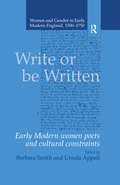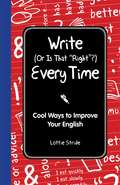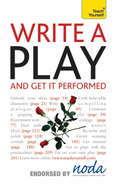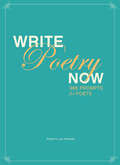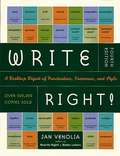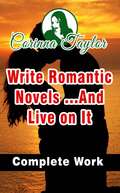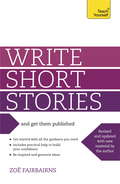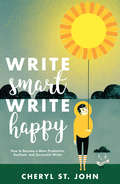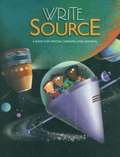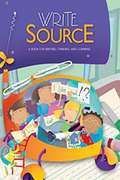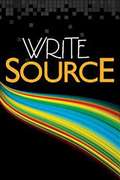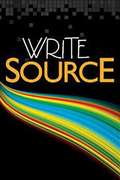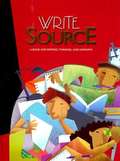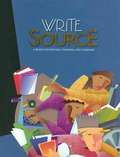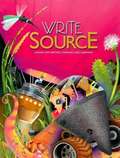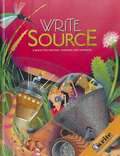- Table View
- List View
Write on Track: A Handbook for Young Writers, Thinkers, and Learners
by Dave Kemper Ruth Nathan Patrick SebranekWhy write? There are many good reasons to write. Writing lets you create stories, poems, and plays. It helps you learn and remember.
Write or be Written: Early Modern Women Poets and Cultural Constraints
by Ursula AppeltAlthough the field of early modern women's studies has blossomed in recent years, little attention has been paid to women poets of the period. This new collection is specifically designed to fill the gap, applying new critical methodologies and theories to this group of early modern writers. Write or Be Written also contributes to ongoing debates about canonicity, periodicity, disciplinarity, and the construction of knowledge. The essays in this volume reflect today's sophisticated critical thinking, and represent a broad range of approaches and methodologies. Topics covered include contextualizing the self; female discursive strategies; religious discourses and gender; writing a female space; negotiating power and desire; female writing and the marketplace/publishing; and revisions of male-dominated poetic conventions and traditions.
Write (Or is it Right?) Every Time
by Lottie StrideAn Apple a Day Keeps the Low Marks Away!Whether you're writing a report or a creative essay, the more you understand about the workings of the English language, the better you'll do. Write (Or Is That "Right"?) Every Time provides a fun-and-easy way to tackle tenses, sort out spelling slip-ups, put a full stop to punctuation problems, and conquer clauses. The book is divided into bite-size chunks, including: Goodness Gracious Grammar: Fun ways to tackle the parts of speech, tenses, conjunctions, and clauses, with rule breakers and amusing examples of bad grammar.Spelling Made Simple: Easy techniques to learn the rules-and exceptions- so you become a spelling whiz (or should that be whiz?).Punctuation Perfection: Effortless ways to conquer those punctuation dilemmas. From exclamation points, colons, and hyphens to all the commas in between.
Write A Play And Get It Performed: Teach Yourself
by Lesley Bown Lesley Hudswell Ann GawthorpeWrite a Play - and Get It Performed is designed for would-be writers of every level and for all types of motivation by two prize-winning professionals. Whether writing for the specific needs of an amateur drama group, community event, political campaign or simply for personal or professional development, this is a guide to the craft of playwriting. It offers guidance on the creative principles of scripts, characters, plot, structure and dialogue and explains the principles of staging and stage directions as well as gives tips on how to write for a variety of different situations, for every age and ability and according to specific genres - particularly those often preferred by amateur groups, such as pantomime and musical theatre.NOT GOT MUCH TIME?One, five and ten-minute introductions to key principles to get you started.AUTHOR INSIGHTSLots of instant help with common problems and quick tips for success, based on the author's many years of experience.TEST YOURSELFTests in the book and online to keep track of your progress.EXTEND YOUR KNOWLEDGEExtra online articles at www.teachyourself.com to give you a richer understanding of writing a play.FIVE THINGS TO REMEMBERQuick refreshers to help you remember the key facts.TRY THISInnovative exercises illustrate what you've learnt and how to use it.
Write Poetry Now: 366 Prompts for Inspiring Your Poems
by Robert Lee BrewerRobert Brewer, editor of Writer's Market and author of the popular poetry blog Poetic Asides, compiles in this book all of his best, most popular and thought-provoking writing prompts for poets. The goal is to create new poems and this book provides 366 - enough for every day of the year! The world needs more poets. So get inspired, get creative, and start writing poetry - now!
Write Right!
by Jan VenoliaIn this age of electronic correspondence and self-produced documents, we need a useful and reliable writing guide more than ever. WRITE RIGHT! covers the essentials of good writing in a concise and easy-to-follow format. The new edition of this classic handbook takes you through the entire writing process, from understanding the parts of speech to constructing a correct sentence to fine-tuning the mechanics. And with clever drawings and amusing quotations to illustrate its points, WRITE RIGHT! shows that language can be fun as well as an effective communication tool. Whether it'¬?s used to find a quick answer to a nagging question or to develop stronger writing skills, this handy reference is the ideal resource for writers of all levels. Ä¢ Previous editions have sold over 500,000 copies. Ä¢ Includes a resource section with a list of helpful websites and a glossary to quickly define difficult terms.From the Trade Paperback edition.
Write Romantic Novels ...And Live on It: Complete Work
by Corinna TaylorThese types of novels are not the same as the historical ones that were established in the period of the regency. They are usually shorter, usually paying attention to the society of the regency and dialogue around action and sex (although Mary Balogh and other authors have introduced sex in this genre) it can be said that these romances should Much to authors as I arrived Georgette Heyer (one of the favorite writers of the SF, author of Lois McMaster Bujold) also to Jane Austen. In spite of everything, the regency of today does not have to be a sitcom. This subgenre can deal with distressed characters, discovering the importance of family life, with heroines forced to sexual abuse, protagonists or women heroines forced to become prostitutes (Mary Balogh, The Secret Pearl). Some writers began writing these types of novels before entering historical romance. Notable names in this genre, especially the humorous regency are Emma Jensen, Barbara Metzger, Diane Farr, Marion Chesney and Kasey Michaels. Notable authors of more serious regencies include Mary Balogh, Carla Kelly, Joan Wolf, Patricia Oliver, Mary Jo Putney, Alison Lane, Elisabeth Fairchild and Jo Beverley.
Write Short Stories and Get Them Published: Teach Yourself
by Zoe FairbairnsWritten by one of the country's leading experts on the short story, this book is ideal if you want to write creatively in a genre that is increasingly attracting attention from publishers, and which offers plenty of competition and festival opportunities for you to showcase your work.This new edition includes uptodate material on web resources and outlets and provides new information on self-publishing. In addition it discusses genres such as micro-fiction, and throughout is fully updated with new resources, events, slams and competitions.It will help unlock your imagination and creativity, and to discover stories you didn't know you had. It will help you to observe the world around you more sharply, as well as to structure, shape and polish your story. It is full of practical exercises that will both inspire imagination and refine skills, and confidence-building suggestions and hints.
Write Short Stories and Get Them Published: Your practical guide to writing compelling short fiction
by Zoe FairbairnsLEARN HOW TO WRITE WONDERFUL AND VARIED SHORT STORIES AND SHARE THEM WITH THE WORLD.Written by one of the country's leading experts on the short story, this book is ideal if you want to write creatively in a genre that is increasingly attracting attention from publishers, and which offers plenty of competition and festival opportunities for you to showcase your work.This new edition includes uptodate material on web resources and outlets and provides new information on self-publishing. In addition it discusses genres such as micro-fiction, and throughout is fully updated with new resources, events, slams and competitions.It will help unlock your imagination and creativity, and to discover stories you didn't know you had. It will help you to observe the world around you more sharply, as well as to structure, shape and polish your story. It is full of practical exercises that will both inspire imagination and refine skills, and confidence-building suggestions and hints.
Write Smart, Write Happy: How to Become a More Productive, Resilient and Successful Writer
by Cheryl St. JohnVanquish Your Writing Doubts & ObstaclesWriting is a vulnerable occupation; it is both personal and intimate. The act of writing, cycles of revision, and the confusing publishing industry can shatter a writer's confidence, leaving you feeling like an imposter, overcome with rejection. Survival--and success--requires commitment, honesty, courage, resilience, sacrifice, and miles and miles of heart.You have everything you need as a writer--it lies within, in the form of consistency and self-confidence. With Write Smart, Write Happy, best-selling author Cheryl St. John will help you unlock your skills, guiding you to overcome every hesitation, obstacle, form of writer's block, and procrastination habit you have. Within these pages, you'll learn to:Organize your writing life by using a planner, scheduling your yearly goals, and acknowledging career plans.Sharpen your saw by recharging your creativity, developing positive motivation, and creating healthy writing habits.Affirm your beliefs by overcoming self-doubt, learning to use affirmations, and altering your thinking.Conquer remaining fears by releasing tendencies towards perfectionism and establishing strategies for habitual success.Written with a no-nonsense attitude, St. John's "advice from the trenches" will help you take an introspective look at your own writing habits and life. Through examples and inspiration from writers who struggled with--and overcame--rejection and reservations, discover the path towards writing smarter and happier today.
Write Source: A Book for Writing, Thinking, and Learning
by Dave Kemper Verne Meyer Patrick SebranekThis powerful classroom toolkit provides a variety of additional resources to help you make the most of the Write Source program: - SkillsBook Practice for essential mechanics, usage, and grammar skills (SkillsBook Teacher's Edition also included. )- Assessment Book Copymasters for a pretest, interim tests, and posttests to help prepare students for stare assessments- Overhead Transparencies Graphic organizers, assessment rubrics, and benchmark papers for whole-class instruction- Interactive Writing Skills CD-ROM Animated grammar lessons, engaging, interactive activities, and printable and e-mailable reports- Daily Language Workouts Quick 5-to-10 minute activities in mechanics, usage, grammar, and writing.
Write Source: A Book for Writing, Thinking, and Learning
by Dave Kemper Patricia Reigel Patrick SebranekThis book is designed to develop writing skills.
Write Source: A Book for Writing, Thinking, and Learning
by Dave Kemper Patrick Sebranek Verne Meyer Chris KrenzkeThis powerful classroom toolkit provides a variety of additional resources to help you make the most of the Write Source program: - SkillsBook Practice for essential mechanics, usage, and grammar skills (SkillsBook Teacher's Edition also included.)- Assessment Book Copymasters for a pretest, interim tests, and posttests to help prepare students for stare assessments- Overhead Transparencies Graphic organizers, assessment rubrics, and benchmark papers for whole-class instruction- Interactive Writing Skills CD-ROM Animated grammar lessons, engaging, interactive activities, and printable and e-mailable reports- Daily Language Workouts Quick 5-to-10 minute activities in mechanics, usage, grammar, and writing.
Write Source: A Book for Writing, Thinking, and Learning
by Dave Kemper Patrick Sebranek Verne Meyer Chris KrenzkeThis powerful classroom toolkit provides a variety of additional resources to help you make the most of the Write Source program: - SkillsBook Practice for essential mechanics, usage, and grammar skills (SkillsBook Teacher's Edition also included.)- Assessment Book Copymasters for a pretest, interim tests, and posttests to help prepare students for stare assessments- Overhead Transparencies Graphic organizers, assessment rubrics, and benchmark papers for whole-class instruction- Interactive Writing Skills CD-ROM Animated grammar lessons, engaging, interactive activities, and printable and e-mailable reports- Daily Language Workouts Quick 5-to-10 minute activities in mechanics, usage, grammar, and writing.
Write Source: A Book for Writing, Thinking, and Learning
by Dave Kemper Patrick Sebranek Verne Meyer Chris KrenzkeThis powerful classroom toolkit provides a variety of additional resources to help you make the most of the Write Source program: - SkillsBook Practice for essential mechanics, usage, and grammar skills (SkillsBook Teacher's Edition also included.)- Assessment Book Copymasters for a pretest, interim tests, and posttests to help prepare students for stare assessments- Overhead Transparencies Graphic organizers, assessment rubrics, and benchmark papers for whole-class instruction- Interactive Writing Skills CD-ROM Animated grammar lessons, engaging, interactive activities, and printable and e-mailable reports- Daily Language Workouts Quick 5-to-10 minute activities in mechanics, usage, grammar, and writing.
Write Source: A Book for Writing, Thinking, and Learning
by Dave Kemper Patrick Sebranek Verne Meyer Chris KrenzkeThis powerful classroom toolkit provides a variety of additional resources to help you make the most of the Write Source program: - SkillsBook Practice for essential mechanics, usage, and grammar skills (SkillsBook Teacher's Edition also included. )- Assessment Book Copymasters for a pretest, interim tests, and posttests to help prepare students for stare assessments- Overhead Transparencies Graphic organizers, assessment rubrics, and benchmark papers for whole-class instruction- Interactive Writing Skills CD-ROM Animated grammar lessons, engaging, interactive activities, and printable and e-mailable reports- Daily Language Workouts Quick 5-to-10 minute activities in mechanics, usage, grammar, and writing.
Write Source: A Book for Writing, Thinking, and Learning
by Dave Kemper Patrick Sebranek Verne Meyer Chris KrenzkeThis powerful classroom toolkit provides a variety of additional resources to help you make the most of the Write Source program: - SkillsBook Practice for essential mechanics, usage, and grammar skills (SkillsBook Teacher's Edition also included. )- Assessment Book Copymasters for a pretest, interim tests, and posttests to help prepare students for stare assessments- Overhead Transparencies Graphic organizers, assessment rubrics, and benchmark papers for whole-class instruction- Interactive Writing Skills CD-ROM Animated grammar lessons, engaging, interactive activities, and printable and e-mailable reports- Daily Language Workouts Quick 5-to-10 minute activities in mechanics, usage, grammar, and writing.
Write Source: A Book for Writing, Thinking, and Learning
by Dave Kemper Patrick Sebranek Verne Meyer Chris KrenzkeNIMAC-sourced textbook
Write Source: A Book for Writing, Thinking, and Learning
by Dave Kemper Patrick Sebranek Verne Meyer Chris KrenzkeThis powerful classroom toolkit provides a variety of additional resources to help you make the most of the Write Source program: - SkillsBook Practice for essential mechanics, usage, and grammar skills (SkillsBook Teacher's Edition also included. )- Assessment Book Copymasters for a pretest, interim tests, and posttests to help prepare students for stare assessments- Overhead Transparencies Graphic organizers, assessment rubrics, and benchmark papers for whole-class instruction- Interactive Writing Skills CD-ROM Animated grammar lessons, engaging, interactive activities, and printable and e-mailable reports- Daily Language Workouts Quick 5-to-10 minute activities in mechanics, usage, grammar, and writing.
Write Source: A Book for Writing, Thinking, and Learning
by Dave Kemper Patrick Sebranek Verne Meyer Chris KrenzkeThis powerful classroom toolkit provides a variety of additional resources to help you make the most of the Write Source program: - SkillsBook Practice for essential mechanics, usage, and grammar skills (SkillsBook Teacher's Edition also included. )- Assessment Book Copymasters for a pretest, interim tests, and posttests to help prepare students for stare assessments- Overhead Transparencies Graphic organizers, assessment rubrics, and benchmark papers for whole-class instruction- Interactive Writing Skills CD-ROM Animated grammar lessons, engaging, interactive activities, and printable and e-mailable reports- Daily Language Workouts Quick 5-to-10 minute activities in mechanics, usage, grammar, and writing.
Write Source: A Book for Writing, Thinking, and Learning
by Dave Kemper Patrick Sebranek Verne Meyer Chris KrenzkeThis powerful classroom toolkit provides a variety of additional resources to help you make the most of the Write Source program: - SkillsBook Practice for essential mechanics, usage, and grammar skills (SkillsBook Teacher's Edition also included. )- Assessment Book Copymasters for a pretest, interim tests, and posttests to help prepare students for stare assessments- Overhead Transparencies Graphic organizers, assessment rubrics, and benchmark papers for whole-class instruction- Interactive Writing Skills CD-ROM Animated grammar lessons, engaging, interactive activities, and printable and e-mailable reports- Daily Language Workouts Quick 5-to-10 minute activities in mechanics, usage, grammar, and writing.
Write Source: A Book for Writing, Thinking, and Learning
by Dave Kemper Patrick Sebranek Verne Meyer Chris KrenzkeThis powerful classroom toolkit provides a variety of additional resources to help you make the most of the Write Source program: - SkillsBook Practice for essential mechanics, usage, and grammar skills (SkillsBook Teacher's Edition also included. )- Assessment Book Copymasters for a pretest, interim tests, and posttests to help prepare students for stare assessments- Overhead Transparencies Graphic organizers, assessment rubrics, and benchmark papers for whole-class instruction- Interactive Writing Skills CD-ROM Animated grammar lessons, engaging, interactive activities, and printable and e-mailable reports- Daily Language Workouts Quick 5-to-10 minute activities in mechanics, usage, grammar, and writing.
Write Source: A Book for Writing, Thinking, and Learning
by Dave Kemper Patrick Sebranek Verne Meyer Chris KrenzkeThis powerful classroom toolkit provides a variety of additional resources to help you make the most of the Write Source program: Skills Book Practice for essential mechanics, usage, and grammar skills. Assessment Book Copy masters for a pretest, interim tests, and posttests to help prepare students for stare assessments- Overhead Transparencies Graphic organizers, assessment rubrics, and benchmark papers for whole-class instruction- Interactive Writing Skills- Animated grammar lessons, engaging, interactive activities, and printable and emailable reports- Daily Language Workouts Quick 5-to-10 minute activities in mechanics, usage, grammar, and writing.
Write Source: A Book for Writing, Thinking, and Learning
by Dave Kemper Patrick Sebranek Verne Meyer Chris KrenzkeThis powerful classroom toolkit provides a variety of additional resources to help you make the most of the Write Source program: - SkillsBook Practice for essential mechanics, usage, and grammar skills (SkillsBook Teacher's Edition also included.)- Assessment Book Copymasters for a pretest, interim tests, and posttests to help prepare students for stare assessments- Overhead Transparencies Graphic organizers, assessment rubrics, and benchmark papers for whole-class instruction- Interactive Writing Skills CD-ROM Animated grammar lessons, engaging, interactive activities, and printable and e-mailable reports- Daily Language Workouts Quick 5-to-10 minute activities in mechanics, usage, grammar, and writing.
Write Source: A Book for Writing, Thinking, and Learning
by Dave Kemper Patrick Sebranek Verne Meyer Chris KrenzkeNIMAC-sourced textbook

